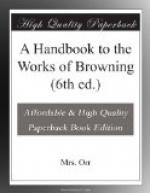“THE BISHOP ORDERS HIS TOMB AT SAINT PRAXED’S CHURCH” (Rome, 15—) displays the artistic emotion in its least moral form: the love of the merely beautiful as such; and it shows also how this may be degraded: by connecting it in the mind of the given person, with the passion for luxury, and the pride and jealousies of possession. The Bishop is at the point of death. His sons (nominally nephews) are about him; and he is urging on them anxious and minute directions for the tomb they are to place for him in St. Praxed’s church.
This tomb, as the Bishop has planned it, is a miracle of costliness and beauty; for it is to secure him a double end: the indulgence of his own tastes, and the humiliation of a former rival who lies modestly buried in the same church. In the delirium of his weakness, these motives, which we imagine always prominent, assume the strength of mania. His limbs are already stiff; he feels himself growing into his own monument; and his fancy revels in the sensations which will combine the calm of death with the consciousness of sepulchral magnificence. He pleads, as for dear life, with those who are to inherit his wealth, and who may at their pleasure fulfil his last wishes or disregard them: that he may have jasper for his tomb—basalt (black antique) for its slab—the rosiest marble for its columns—the richest design for its bronze frieze! A certain ball of lapis-lazuli (such as never yet was seen) is to “poise” between his knees; and he gasps forth the secret of how he saved this from the burning of his church, and buried it out of sight in a vineyard, as if he were staking his very life on the revelation.
But in his heart he knows that his entreaties are useless: that his sons will keep all they can; and the tone of entreaty is dashed with all the petulance of foreseen disappointment. Weakness prevails at last. He resigns himself to the inevitable; blesses his undutiful sons; and dismisses them.
Other strongly dramatic details complete the picture.[76]
“A TOCCATA OF GALUPPI’S” is a fantastic little vision of bygone Venice, evoked by the music of an old Venetian master, and filling us with the sense of a joyous ephemeral existence, in which the glow of life is already struck by the shuddering chill of annihilation. This sense is created by the sounds, as Mr. Browning describes them: and their directly expressive power must stand for what it is worth. Still, the supposed effect is mainly that of association; and the listener’s fancy the medium through which it acts.
“A FACE” describes a beautiful head and throat in its pictorial details—those which painting might reproduce.
“THE GUARDIAN-ANGEL” and “EURYDICE TO ORPHEUS” describe each an actual picture in the emotions it expresses or conveys.




